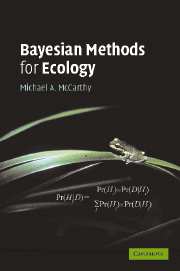Book contents
- Frontmatter
- Contents
- Preface
- 1 Introduction
- 2 Critiques of statistical methods
- 3 Analysing averages and frequencies
- 4 How good are the models?
- 5 Regression and correlation
- 6 Analysis of variance
- CASE STUDIES
- APPENDICES
- A A tutorial for running WinBUGS
- B Probability distributions
- C MCMC algorithms
- References
- Index
A - A tutorial for running WinBUGS
Published online by Cambridge University Press: 05 June 2012
- Frontmatter
- Contents
- Preface
- 1 Introduction
- 2 Critiques of statistical methods
- 3 Analysing averages and frequencies
- 4 How good are the models?
- 5 Regression and correlation
- 6 Analysis of variance
- CASE STUDIES
- APPENDICES
- A A tutorial for running WinBUGS
- B Probability distributions
- C MCMC algorithms
- References
- Index
Summary
Before running WinBUGS, you will need to download it from the WinBUGS website. The latest version of WinBUGS is OpenBUGS, using open source software, which can be obtained at:
http://mathstat.helsinki.fi/openbugs/
Older versions of WinBUGS can be obtained from
http://www.mrc-bsu.cam.ac.uk/bugs/winbugs/contents.shtml
The older versions of WinBUGS require a key for full functionality, which requires that you register (for free). The newer OpenBUGS version does not require a key. Once you have downloaded and installed the software, you are ready to run WinBUGS. The following tutorial is based on the one provided with the program.
A summary of steps for running WinBUGS
Select the term ‘model’ and then ‘check model’.
Select the data and load.
Compile the model.
Set initial values for the Markov chain.
Set variables to be sampled.
Take samples.
Check samples.
The steps in more detail
This tutorial steps through how to analyse a mean in WinBUGS, using the example of estimating the average tree diameter in a park (Box 1.8). It is based on the online User Manual in the WinBUGS program.
- Type
- Chapter
- Information
- Bayesian Methods for Ecology , pp. 249 - 254Publisher: Cambridge University PressPrint publication year: 2007

